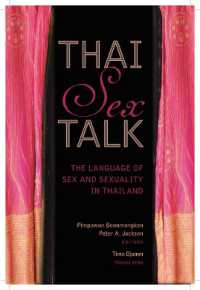- ホーム
- > 洋書
- > 英文書
- > Biography / Autobiography
基本説明
New in paperback. Hardcover was published in 2008. Explains how and why Mead became the best-known anthropologist and female public intellectual in twentieth-century America.
Full Description
'Never doubt that a small group of thoughtful, committed citizens can change the world' - Margaret Mead. This quotation - found on posters and bumper stickers, and adopted as the motto for hundreds of organizations worldwide - speaks to the global influence and legacy of the American anthropologist Margaret Mead (1901-78). In this insightful and revealing book, Nancy Lutkehaus explains how and why Mead became the best-known anthropologist and female public intellectual in twentieth-century America. Using photographs, films, television appearances, and materials from newspapers, magazines, and scholarly journals, Lutkehaus explores the ways in which Mead became an American cultural heroine.Identifying four key images associated with her - the New Woman, the Anthropologist/Adventurer, the Scientist, and the Public Intellectual - Lutkehaus examines the various meanings that different segments of American society assigned to Mead throughout her lengthy career as a public figure.The author shows that Mead came to represent a new set of values and ideas - about women, non-Western peoples, culture, and America's role in the twentieth century - that have significantly transformed society and become generally accepted today. Lutkehaus also considers why there has been no other anthropologist since Mead to become as famous. "Margaret Mead" is an engaging look at how one woman's life and accomplishments resonated with the issues that shaped American society and changed her into a celebrity and cultural icon.
Contents
List of Illustrations ix Preface xi Acknowledgments xv IntroductionMead as American Icon 1 Chapter 1. Mead as Modern Woman 25 Chapter 2. Images of the Mature Mead 58 Chapter 3. Mead as Anthropologist: "Sex in the South Seas" 83 Chapter 4. Mead as Anthropologist: "To Study Cannibals" 113 Chapter 5. Mead as Anthropologist: "To Find Out How Girls Learn to Be Girls" 133 Chapter 6. Mead and the Image of the Anthropologist 151 Chapter 7. Mead as Scientist 165 Chapter 8. Mead as Public Intellectual and Celebrity 205 Chapter 9. The Posthumous Mead, or Mead, the Public Anthropologist 238 Abbreviations of Archival Sources 265 Notes 267 Bibliography 331 Index 361















